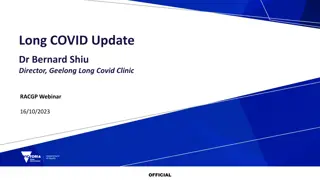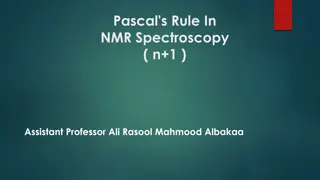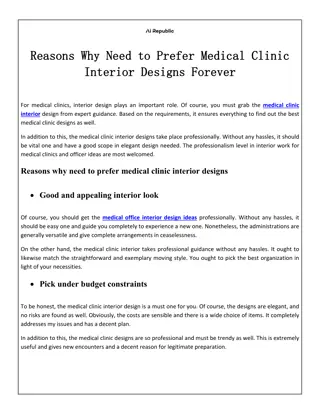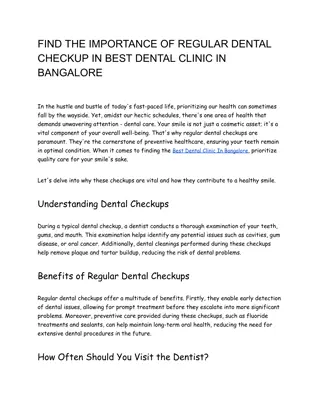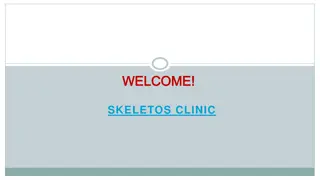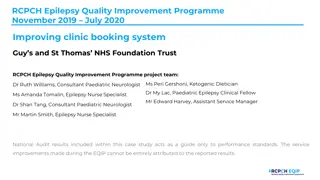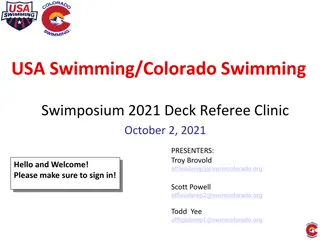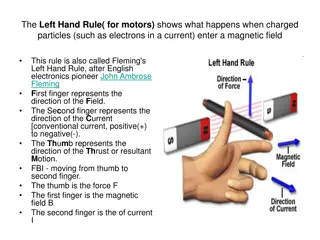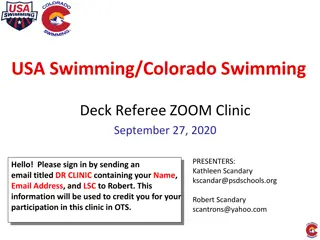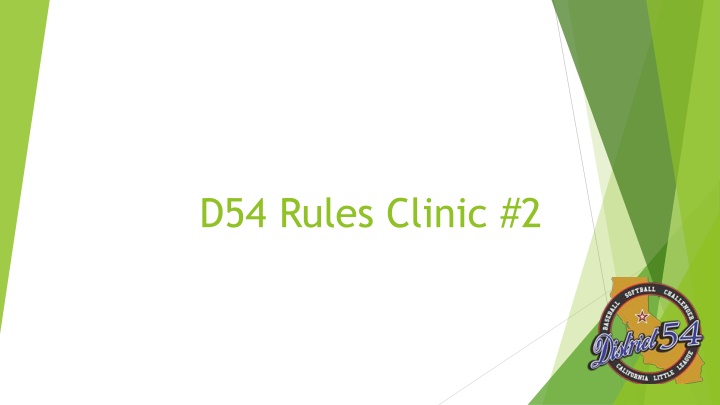
Little League Rules Clinic: Objectives, Updates, and Clinics Schedule
Explore the objectives of Little League baseball and softball, upcoming rules clinics, and important references for 2022. Learn about team composition, winning objectives, and details of the game. Enhance your knowledge and stay updated with the latest information.
Download Presentation

Please find below an Image/Link to download the presentation.
The content on the website is provided AS IS for your information and personal use only. It may not be sold, licensed, or shared on other websites without obtaining consent from the author. If you encounter any issues during the download, it is possible that the publisher has removed the file from their server.
You are allowed to download the files provided on this website for personal or commercial use, subject to the condition that they are used lawfully. All files are the property of their respective owners.
The content on the website is provided AS IS for your information and personal use only. It may not be sold, licensed, or shared on other websites without obtaining consent from the author.
E N D
Presentation Transcript
Ground Rules Please mute when not asking a question In the chat let me know your name, league and role (UIC, volunteer umpire, youth umpire, coach, etc.) No flash photography
Agenda References Upcoming Clinics Objectives of the Game Rules Updates for 2022
References District Website https://ca54littleleague.com Western Region Upcoming Clinics https://www.littleleague.org/region/west-region Little League RIM (Rules Instruction Manual) Umpire Registry https://littleleagueumpire.org
Upcoming Clinics Rules Clinics Jan 26th -Definitions Part 1: Game Prelim, Starting the Game, and Live Ball Feb 9th- Definitions Part 2: Interferences, Obstruction, and The Batter Feb 23rd- Definitions Part 3: The Runner, The Pitcher March 9th Game Coordinator Mechanics Clinics Feb 5thto Feb 11th- Western Region, San Berandino Feb 12th Mahany Sports Complex: 1545 Pleasant Grove Blvd, Roseville 95747 Feb 19th McFarland Park, 1780 E Natoma St, Folsom, CA 95630
Objectives of the Game Rule 1.01 Little League Baseball and Softball in all divisions is a game between two teams of nine players each Under the direction of a manager and not more than two (2) rostered coaches Played on a regulation Little League field in accordance with these rules, under jurisdiction of one or more umpires. Tee Ball/Minor League Instructional Division is a game between two teams, under the direction of a manager and not more than three rostered coaches, played on a regulation Little League field in accordance with these rules, under the jurisdiction of one or more umpires. NOTE: Competitive Minor Leagues and above may only use nine (9) players on defense. Local League Option: A game may not be started with less than eight (8) players on each team. See Rules 4.16 and 4.17. Local leagues can permit to start a game with 8 players
Objectives of the Game 1.02 & 1.03 1.02 - The objective of each team is to win by scoring more runs than the opponent. (Tee Ball: It is recommended that no score be kept.) 1.03 - The winner of the game shall be that team which shall have scored, in accordance with these rules, the greater number of runs at the conclusion of a regulation game.
Objectives of the Game The Playing Field (1.04) THE PLAYING FIELD. The field shall be laid out according to the instructions, supplemented Diagram by No. 1 and The infield shall be a 60-foot square. Diagrams No. 3, No. 4 and No. 5 for Intermediate (50-70) Division/Junior/Senior League. (BASEBALL) (TEE BALL OPTION: The infield may be a 50-foot square.) [Intermediate (50-70) division baseball: 90-foot square.] [Junior/senior league BASEBALL: 90-foot square.] [CHALLENGER: The infield shall be a 50- or 60-foot square.] The outfield shall be the area between two foul lines formed by extending two sides of the square, as in Diagram 1. The distance from home base to the nearest fence, stand, or other obstruction on fair territory should be 200 feet or more BASEBALL: [200 feet or more for Intermediate (50-70) Division and 300 feet or more for Junior/Senior League]. A distance of 200 feet or more [200 feet or more for Intermediate (50-70) Division and 300 feet or more for Junior/Senior League] along the foul lines and to center field is recommended. The infield shall be graded so that the base lines and home plate are level.
Objectives of the Game Playing Field 1.04
Objectives of the Game 1.05 Home base shall be marked by a five-sided slab of whitened rubber. It shall be a 17-inch square with two of the corners filled in so that one edge is 17 inches long, two 81/2 inches and two are 12 inches. It shall be set in the ground with the point at the intersection of the lines extending from home base to first base and to third base; with the 17- inch edge facing the pitcher s plate and the two 12-inch edges coinciding with the first and third base lines. The top edges of home base shall be beveled and the base shall be fixed in the ground level with the ground surface. The black beveled edge is not considered part of home plate.
Objectives of the Game 1.06 First, second, and third bases shall be marked by white canvas or rubber covered bags, securely attached to the ground. The first and third base bags shall be entirely within the infield. The second base bag shall be centered on second base. The base bags shall not be less than fourteen (14) nor more than fifteen (15) inches square and the outer edges shall not be more than two and one-fourth (2 1/4) inches thick and filled with a soft material. Leagues are required to ensure that first, second, and third bases will disengage their anchor. NOTE 1: If a base is dislodged from its position during a play, any following runner on the same play shall be considered as touching or occupying the base if, in the umpire s judgment, that runner touches or occupies the dislodged bag or the point marked by the original location of the dislodged bag. NOTE 2: Use of the Double First Base is permissible at all levels of play. See Rule 7.15.
Objectives of the Game 1.07 The pitcher s plate shall be a rectangular slab of whitened rubber... BASEBALL: 18 inches by 4 inches [24 inches by 6 inches for Intermediate (50-70) Division/Junior/Senior League]. It shall be set in the ground as shown in the Diagrams 6 and 7, so that the distance between the front side of the pitcher s plate and home base (the rear point of home plate) shall be 46 feet [50 feet for Intermediate (50-70) Division and 60 feet, 6 inches for Junior/Senior League];
Objectives of the Game 1.08 The league shall furnish players benches, one each for the home and visiting teams. Such benches should be not less than 25 feet from the base lines. They shall be protected by wire fencing. NOTE 1: The on-deck position is not permitted in Tee Ball, Minor League, or Little League (Major) Division. Fenced-in areas MAY NOT be used for an on-deck batter. NOTE 2: Only the first batter of each half-inning will be permitted outside the dugout between half-innings in Tee Ball, Minor League, or Little League (Major) Division. The next batter should be ready with a helmet on but may not pick up a bat until it is his/her turn at bat.
When is the best time to look for legal/illegal equipment?
Objectives of the Game 1.09 BASEBALL: The ball used must meet Little League specifications and standards. It shall weigh not less than five (5) nor more than five and one-fourth (5 Va) ounces, and measure not less than nine (9) nor more than nine and one- fourth (9Va) inches in circumference. (Tee Ball: The ball may carry the words Little League Tee Ball. ) NOTE: Baseballs licensed by Little League will be printed with one of two designations: RS (for regular season play) or RS-T (for regular season and tournament play).
BASEBALL: The bat must be a baseball bat which meets USA Baseball Bat standard (USABat) as adopted by Little League. It shall be a smooth, rounded stick, and made of wood or of material and color tested and proved acceptable to the USA Baseball Bat standard (USABat). Non-wood and laminated bats used in the Little League (Majors) and below, Intermediate (50-70) Division, and Junior League divisions shall bear the USA Baseball logo signifying that the bat meets the USABat - USA Baseball s Youth Bat Performance Standard. All BPF -1.15 bats are prohibited. The bat diameter shall not exceed 2 5/8 inches for these divisions of play. Bats meeting the Batted Ball Coefficient of Restitution (BBCOR) standard may also be used in the Intermediate (50-70) Division and Junior League Division. Additional information is available at LittleLeaque.org/Batlnfo. Objectives of the Game 1.10
Objectives of the Game 1.10 Minor/Major Divisions: It shall not be more than 33 inches in length; nor more than 2 5/8 inches in diameter, and if wood, not less than fifteen- sixteenths(15/16) inches in diameter (7/8 inch for bats less than 30 ) at its smallest part. Wood bats taped or fitted with a sleeve may not exceed sixteen (16) inches from the small end. NOTE 1: Solid one- piece wood barrel bats do not require a USA Baseball logo NOTE 2: Approved Tee Ball bats may also be used for Coach Pitch/Machine Pitch Minor Divisions only with the use of approved Tee Balls.
Objectives of the Game 1.10 Intermediate (50-70) Division and Junior League: It shall not be more than 34 inches in length; nor more than 2 5/8 inches in diameter, and if wood, not less than fifteen-sixteenths (15/16) inches in diameter (7/8 inch for bats less than 30 ) at its smallest part. Wood bats taped or fitted with a sleeve may not exceed eighteen inches from the small end. NOTE 1: Solid one-piece wood barrel bats do not require a USA Baseball logo. NOTE 2: Also, permitted for the Intermediate (50-70) Division and Junior League Division are bats meeting the BBCOR performance standard, and so labeled with a silkscreen or other permanent certification mark. The certification mark shall be rectangular, a minimum of a half-inch on each side and located on the barrel of the bat in any contrasting color. Aluminum/alloy and composite bats shall be marked as to their material makeup composite. This marking shall be silkscreen or other permanent certification mark, a minimum of one-half-inch on each side and located on the barrel of the bat in any contrasting color. being aluminum/alloy or
Objectives of the Game 1.10 Senior League: It shall not be more than 36 inches in length, nor more than 2 5/8 inches in diameter, and if wood, not less than fifteen-sixteenths (15/16) inches in diameter (7/8 inch for bats less than 30 ) at its smallest part. Wood bats taped or fitted with a sleeve may not exceed eighteen (18) inches from the small end. The bat shall not weigh, numerically, more than three ounces less than the length of the bat (e.g., a 33-inch-long bat cannot weigh less than 30 ounces). All bats not made of a single piece of wood shall meet the Batted Ball Coefficient of Restitution (BBCOR) performance standard, and such bats shall be so labeled with a silkscreen or other permanent certification mark. The certification mark shall be rectangular, a minimum of a half-inch on each side and located on the barrel of the bat in any contrasting color. Aluminum/alloy and composite bats shall be marked as to their material makeup being aluminum/alloy or composite. This marking shall be silkscreen or other permanent certification mark, a minimum of one-half-inch on each side and located on the barrel of the bat in any contrasting color.
Objectives of the Game 1.10 In all divisions, non-wood bat must have a grip of cork, tape, or composition material, and must extend a minimum of 10 inches from the small end. Slippery tape or similar material is prohibited. NOTE 1: The traditional batting donut is not permissible. NOTE 2: The use of pine tar or any other similar adhesive substance is prohibited at all levels of Little League Baseball. Use of these substances will result in the bat being declared illegal and removed from play. If all residual pine tar is removed from the bat and the bat otherwise complies with Rule 1.10 the bat may be used in the game. NOTE 3: Non-wood bats may develop dents from time to time. Bats that have cracks or sharp edges, or that cannot pass through the approved Little League bat ring for the appropriate division must be removed from play. The 2 1/4- inch bat ring must be used for bats labeled 2 1/4. The 2 5/8-inch bat ring must be used for bats labeled for 2 5/8. NOTE 4: An illegal bat must be removed. Any bat that has been altered shall be removed from play. PENALTY - See Rule - 6.06(d). If the certification mark/s on a bat are not legible, that bat cannot be used and shall be removed from the game.
You make the call Ralph comes to bat, in a Little League Majors baseball game, with a bat which is 34 inches long (always trying for that little edge). He hits a home run to deep center field; umpire notices that the bat is 34 inches long. Ruling: This is an illegal bat for this division. The home run is disallowed, any runners that were on base are returned to their base/s at the time of the pitch, Ralph is called out, and for the first offense, the offensive team will lose one eligible adult base coach for the duration of the game.
You make the call During your pregame equipment inspection you notice a bat that is 2 diameter. Ruling: If illegal bats are found during pre-game activities, remove them from the dugout. There will be no penalties assessed to the player, manager, or coaches at this time.
Objectives of the Game 1.11 (a)(1) - All players on a team shall wear numbered uniforms identical in color, trim, and style. (a)(2) - The Little League Official Shoulder Patch must be affixed to the upper left sleeve or left chest of the uniform shirt. Patches shall be placed centered on the left shoulder sleeve; or, centered on the left chest for sleeveless style. The patch may not be screen-printed or sublimated. (a)(3) - Any part of the pitcher s undershirt or T-shirt exposed to view shall be of a solid color. A pitcher shall not wear any items on his/her hands, wrists, or arms which may be distracting to the batter. NOTE: BASEBALL: A pitcher shall not wear any items on his/her hands or wrists, or arms which may be distracting to the batter, e.g. sweat bands.
Objectives of the Game - 1.11 (b) - A league must provide each team with a distinctive uniform. Uniforms are the property of the league. Tee Ball/Minor League: T-shirts and caps/ visors are recommended, but hand-me-down uniforms may be worn. (c) - Sleeve lengths may vary for individual players, but the sleeves of each individual shall be approximately the same length. No player shall wear ragged, frayed, or slit sleeves. (d) - No players shall attach to a uniform tape or other material of a different color than the uniform. (e) - No part of the uniform shall include a pattern that imitates or suggests the shape of a (baseball or softball). (f) - Glass buttons and polished metal shall not be used on a uniform. (g) - No player shall attach anything to the heel or toe of the shoe other than a toe plate.
Objectives of the Game 1.11 (h) - Shoes with metal spikes or cleats are not permitted. Shoes with molded cleats are permissible. [Baseball: Intermediate (50-70) Division/Junior/Senior League: shoes with metal spikes or cleats are permitted. (i) - Managers and coaches must not wear conventional baseball uniforms or shoes with metal spikes but may wear cap, slacks, and shirt. [Intermediate (50-70) Division/Junior/Senior League: Managers and coaches may wear conventional baseball uniforms or cap, slacks, and shirts. They may not wear shoes with metal spikes.]
Objectives of the Game - 1.11 (j) - Players must not wear jewelry such as, but not limited to, rings, watches, earrings, bracelets, necklaces, nor any hard cosmetic/decorative items. This rule applies regardless of the composition of such jewelry, hard cosmetic item, or hard decorative item. EXCEPTION: Jewelry that alerts medical personnel to a specific condition is permissible. Players may wear Medical Alert necklaces or bracelets. If a player wears a Medical Alert necklace or bracelet and there is concern the item will get caught in a glove, uniform or by another player tape it to the wrist or chest, but do not ever cover the alert tag. Ensure that the tag is able to be seen by everyone, especially medical personnel. Managers, coaches, players, and umpires may not wear pins in their hats. This rule now makes it very clear as to what is considered jewelry. If it isn t something for a medical condition, it is jewelry!
Objectives of the Game 1.11 (k) - Casts may not be worn during the game by players and umpires. NOTE: Persons wearing casts, including managers and coaches, must remain in the dugout during the game. The word Plaster has been removed from this rule to include other types of casts that can be just as dangerous to the game participants. Players, managers and coaches with casts may not coach in the coaches box, not only out of concern for the injured player, manager or coach, but also for the safety of those around him/her. Umpires may not umpire while wearing a cast for the very same reason.
Objectives of the Game 1.12 The catcher must wear a catcher s mitt (not a first baseman s mitt or fielder s glove) of any shape, size, or weight consistent with protecting the hand. Whether the catcher is a right- handed or left-handed catcher, a catcher s mitt must be worn. A left-handed catcher may not wear a mitt designed for a right- handed catcher, unless the mitt is specifically designed to be worn on either hand.
Objectives of the Game 1.13 The first baseman must wear a glove or mitt of any weight with the following maximum specifications: (A) not more than 14 inches long (measured from the bottom edge or heel straight up across the center of the palm to a line even with the highest point of the glove or mitt), and; (B) not more than eight inches wide across the palm (measured from the bottom edge of the webbing farthest from the thumb in a horizontal line to the outside of the little finger edge of the glove or mitt) and; (C) webbing not more than 53/4inches wide (measured across the top end or along any line parallel to the top).
Objectives of the Game 1.14 Each defensive player (other than the first baseman and catcher) must wear a glove of any weight, with the maximum specifications as noted in Rule 1.13. In Baseball, only the first baseman may wear a first baseman s mitt
Objectives of the Game - 1.15 The pitcher s glove may not, exclusive of piping, be white or light gray nor, in the judgment of an umpire, distracting in any manner No pitcher shall attach to the glove any foreign material of a color different than the glove. The pitcher may wear a batting glove on the non-pitching hand under the pitcher s glove provided the batting glove is not white, gray or optic yellow. Ribbons, key chains, etc. (foreign materials) may not be attached to a glove of the pitcher. By definition foreign material is material not attached by the manufacturer. If the pitcher wears a batting glove he/she may not then rub the ball while still wearing the batting glove. He/she is only permitted to rub up the ball between the bare hands. See Rule 8.02(a)(b)
Objectives of the Game - 1.16 Each league shall provide in the dugout or bench of the offensive team six (6), seven (7) for Intermediate (50-70) Division/Junior/Senior League] protective helmets which must meet NOCSAE (National Operating Committee on Standards for Athletic Equipment) specifications and standards. Use of the helmet by the batter, all base runners and youth base coaches is mandatory. Use of a helmet by an adult base coach or any defensive player is optional. Each helmet shall have an exterior warning label. Helmets must have a non-glare surface and cannot be mirror-like in nature. The helmets provided by each league must meet NOCSAE specifications and bear the NOCSAE stamp as well as an exterior warning label as noted above. Warning! Manufacturers have advised that altering helmets in any way can be dangerous. Altering the helmet in any form, including painting or adding decals (by anyone other than the manufacturer or authorized dealer) may void the helmet warranty. Helmets may not be re-painted and may not contain tape or re-applied decals unless approved in writing by the helmet manufacturer or authorized dealer.
Objectives of the Game 1.17 All male players must wear athletic supporters. Male catchers must wear the metal, fiber or plastic type cup, and a long or short model chest protector. Female catchers must wear long or short model chest protectors. [Intermediate (50- 70) Division/Junior/Senior League Baseball/Junior/Senior League Softball catchers must wear approved long or short model chest protector] All catchers must wear chest protectors with neck collar, throat guard, shin guards and a catcher's helmet, all of which must meet Little League specifications and standards, and bear the NOCSAE stamp. All catchers must wear a mask, dangling type throat protector and catcher s helmet during infield/outfield practice, pitcher warm-up and games. NOTE: Skullcaps are not permitted. Warning! Manufacturers have advised that altering helmets in any way can be dangerous. Altering the helmet in any form, including painting or adding decals (by anyone other than the manufacturer or authorized dealer) may void the helmet warranty. Helmets may not be repainted and may not contain tape or reapplied decals unless approved in writing by the helmet manufacturer or authorized dealer.
Rule updates for 2022 [Baseball, Softball, and Challenger] - Regulation IV(i), Rules 2.00 and 3.03(a), Tournament Rule 9(e) - Mandatory Play/At-Bat Definition. An AT-BAT, for the purposes of meeting the requirements of Mandatory Play (if applicable), is when a player assumes the position of a batter with no count and one of the following occurs: He/she is retired as a batter; or He/she is retired as a batter-runner; or He/she reaches base and scores; or After he/she reaches base, the inning or game ends. APPROVED RULING: While at-bat, if the third out of the half-inning is recorded by putting out another base-runner prior to the occurrence of any of the above, that batter must return as the first batter in the next half-inning. NOTE: For the purpose of satisfying the requirements of Mandatory Play, when appearing offensively for the first time in the game, a player must remain in the game until one of the following occurs: He/She is retired as a batter; or He/She is retired as a batter-runner; or, He/She reaches base and scores: or After he/she reaches base, the inning or game ends.
Rule updates for 2022 Regulation VI(c); Tournament Rule 4(d) (and all other instances of exemption ) EXCEPTION: If a pitcher reaches the limit imposed in Regulation VI(c) for his/her league age while facing a batter, the pitcher may continue to pitch until any one of the following conditions occurs: 1. That batter reaches base; 2. That batter is put out; 3. The third out is made to complete the half-inning or the game; 4. The pitcher is removed from the mound prior to the batter completing his/her at bat. Regulation VI(d); Tournament Rule 4(e) (and all other instances of threshold ) Note 2: A pitcher s pitch count for the purposes of day(s) rest threshold is determined by the first pitch thrown to a batter. The pitcher may not start a new batter once the limit imposed in Regulation VI(c) has been met.
Rule updates for 2022 [Baseball, Softball, and Challenger] - Rule 1.11 (a)(2); Policy: The Official Shoulder Patch. Updates the Little League Official Patch to reflect that new for 2022, Little League International has established a new, unified patch that reflects all levels of the program. This patch, which matches our new Little League logo, can be used, regardless of the division of play, on your league s uniforms. Rocker patches that can go above the new patch for all divisions and roles will also be available, for those who wish to add those distinctions to your uniforms. If your league still has patches that have been previously purchased, you do not need to replace those patches, and limited quantities of our previous patches are still available, while supplies last. Additional information can be found at LittleLeague.org/Patch.


